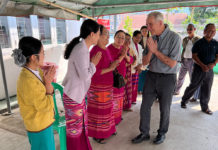Egg hunt
Editor: I just wanted to say ‘hello’ to all my friends in Healdsburg. It’s Easter time, and I’ll be coming to visit you again this SATURDAY. Please remind your parents to bring you to the big egg hunt Saturday morning. My friend Santa Claus told me that the Healdsburg kids are the nicest, so I want to meet you all.
Healdsburg Rotary is again sponsoring the Annual Easter egg hunt. It will take place this Saturday, April 7, at the Fitch Mountain Elemtary School at University and Monte Vista. It starts promptly at 9 a.m. My bunny friends will be hiding hundreds of dyed Easter eggs, and also candies and other goodies. Also … I will be giving away 3 bicycles from Spoke Folk cyclery … free. We will raffle them off Saturday morning. All Healdsburg kids are welcome to join us. There are separate sections for differnet age groups … even a very special section for toddlers.
Please remind your parents to be on time. Also tell them that I will be there, so they should bring their cameras to take pictures with me. I hope to see you Saturday morning at 9 a.m.
The Easter Bunny
Healdsburg
Smashing success
Editor: As a longtime Raven actor and season ticket subscriber, I’d like to congratulate John DeGaetano, president of the Raven Players, for his stellar stage direction that made Chicago, The Musical such a smashing success at the Raven Theater and at Spreckels Performing Arts Center in Rohnert Park. John fought for three years to get the first North Bay rights to Chicago. And because of John’s long, persevering battle, Chicago is the Raven Players biggest musical success. In fact, John has directed all three of the Raven Players top-grossing musicals: 3) Miss Saigon, 2) Cats, and 1) Chicago. I was fortunate to be a part of the CATS cast. On behalf of John’s large, devoted following of actors, dancers, musicians, and support technicians, I would like to thank John DeGaetano and his fellow Raven Players Board members — Sherry Garner, Audie Foote, Pamela Skidmore, Dick Bertapelle, Kathy Taylor, Joe Gellura, and Jeanne Fitzgerald — for so generously volunteering their time, money, and theatrical expertise in order to create that magical Raven stage where “hams” can “strut their stuff.”
By the way, don’t miss the next Raven Players production of To Kill A Mockingbird, running April 13 to April 29. (“Y’All come, her-ah!”)
Billy Ray Garner
(Gus The Theater Cat)
Healdsburg
Credibility
Editor: I suggest that U. S. Secretary of State Hillary Clinton should stop grandstanding about what President Assad of Syria should do and concentrate on her job at home. We have millions of Americans in poverty. We have children who don’t have enough to eat or adequate medical care. We have thousands veterans of wars which Mrs. Clinton supported who are homeless. Portions of our society are routinely denied basic human rights. We inflict torture on humans, including own citizens, as cruel as anything Assad has done.
Mrs. Clinton, your credibility is gone and we’re not buying it anymore. You need to stay home and clean up your own back yard before you try to throw stones at anyone else.
Mike Rosen
Healdsburg
Native plants, pollinators
Editor: I want to provide another perspective from the one presented in “Bringing Pollinators to the Garden: Plantings that create habitat” (March 29) which primarily focused on nonnatives plants and visiting pollinators. Creating a habitat for winged beings, from my viewpoint, is about whole ecology, AKA living ecosystem, in other words providing what insects and hummingbirds have evolved with. While nonnative plants may provide nectar for butterflies, they do not provide choice vegetation for hibernation nor food, particularly in the case of caterpillars. Food plants are butterfly specific: monarch butterflies lay their eggs on milkweed, and since our Western monarchs migrate within California, the desired milkweed is local native varieties; the Pipevine Swallowtail lays her eggs on the California Pipevine which is the food plant for the hatched caterpillar; the Anise Swallowtail prefers the native Coastal Angelica and Yampah but has adapted to its cousins, culinary parsley, both culinary and wild fennel; and on goes the list.
While it is true butterflies like flower “pads” , a gardener in the know does not have to plant the Butterfly Bush which is an exotic originating in China. It is a “weedy colonizer” and invasive weed causing serious problems for the migrating salmon here on the West Coast. The beautiful local Buckeye tree provides nectar during its blooming cycle as do the numerous varieties of California wild lilacs(Ceantothus). Native sunflowers, buckwheat, elderberry, gum plants (Grindelia) and asters as well all provide nectar throughout the butterflies’ short life.
And did you know that the California native bunch grasses are food plants for certain butterflies?
Toxic sprays, including but not limited to Roundup, do (not “can”) kill caterpillars and without caterpillars, no butterflies. Good old fashioned weeding is the best way to rid your garden of undesired plants.
Now hummingbirds with their long bills, they like different kind of flowers. We have a year round resident, Anna’s Hummingbird, for which manzanita varieties provide nectar during the Winter. With just a bit of sunshine during and after the rains, the Fushsia flowering Gooseberry bursts with tubular red flowers to which the Anna’s flock. Native penstamons and columbines provide nectar during the Summer months. In the last week or so the Allen’s Hummingbirds have returned to our West Sonoma County site, so other species will soon follow just in time to enjoy the blossoms of the Twinberry (a native honeysuckle shrub) and a bit later the wild honeysuckle vine. And an added later bonus is berries available for birds!
And I must say, before I removed four varieties of Camellias from my garden, no native bees visited the flowers. Camellia flowers occur mostly in the Winter when our native bees are mostly resting.
Mostly Natives Nursery in Tomales has great lists (both in paper form you may pick up at the nursery or online) for Plants to attract butterflies, Beyond butterflies and more. Nancy Bauer has written a lovely little book: The Habitat Garden Book: Wildlife Landscaping for the San Francisco Bay Region which is helpful for starting a garden that is a living ecosystem. And anyone interested in viewing one of these dynamic gardens can visit MuRefuge in rural residential Sonoma County. Talk/Tours are offered monthly during Spring, Summer and Fall. For more information, e-mail me at af**@so***.net or look at my latest blog post titled Housing and Food http://beingrooted.blogspot.com/2012/03/housing-and-food.html.
Cathie Haynes
Sebastopol
50.9
F
Healdsburg
April 22, 2025








